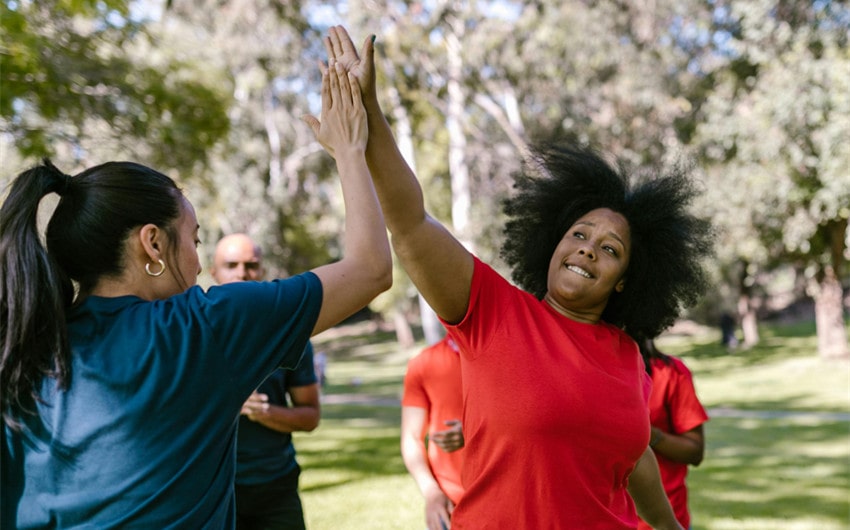25 Fun Games to Play with Friends Without Anything Required
When you’re with friends and have no equipment, props, or gadgets, there are still plenty of ways to have a great time together. There are many games to play with friends without anything—from quick-thinking word games to hilarious improv activities—that require only your creativity and a sense of fun.
These games are perfect for bonding, passing time, and creating memories without the need for tools or preparation. In this article, you’ll find a collection of fun and engaging games to enjoy anywhere, anytime, keeping the laughs and excitement going with just each other’s company.
Classic Verbal Games

Classic verbal games are ideal for sparking conversation, laughter, and friendly competition without any materials. Games like Would You Rather? and 20 Questions rely on quick thinking, creative answers, and often reveal fun insights about friends. These games are perfect for bonding and keeping everyone engaged, whether you’re sharing quirky truths or choosing between funny scenarios.
1. 20 Questions:
One person silently thinks of a specific person, place, or object, and the others must guess what it is by asking up to 20 yes-or-no questions. Questions might include “Is it something you’d find indoors?” or “Does it have wheels?”
This game is all about asking smart, deductive questions that get everyone closer to the answer. The final guess often brings suspense, laughter, and sometimes surprising revelations.
2. Would You Rather?:
In this game, players take turns asking each other questions starting with “Would you rather…” followed by two tricky or humorous choices, like, “Would you rather only eat pizza for a year or never eat pizza again?”
It’s a game that often leads to laughs, debates, and insight into each other’s personalities as everyone explains why they chose one option over the other.
3. Two Truths and a Lie:
Each player shares three statements about themselves—two true and one false—while others try to guess which statement is the lie. For instance, someone might say, “I once met a celebrity, I can juggle, and I have a pet snake.”
This game is perfect for learning fun, unexpected facts about friends, with plenty of laughs and surprises when players reveal the truth.
4. Never Have I Ever:
Players take turns saying, “Never have I ever…” followed by something they’ve never done, like, “Never have I ever traveled outside the country.” Anyone who has done it raises a finger (or takes a point).
The game can get playful and insightful as it highlights unique experiences among friends, sparking storytelling and laughter along the way.
5. The Movie Game:
One player names a famous actor or actress, like “Tom Hanks,” and the next player must name a movie they starred in, such as “Forrest Gump.” The following player names another actor from that movie, and the chain continues.
This game is great for movie buffs and can challenge even the most knowledgeable friend groups to recall films, actors, and fun connections.
Physical Games That Don’t Require Equipment

Physical games are energetic and playful, requiring only an open space and willing participants. Games like Freeze Tag and Red Light, Green Light are simple but bring tons of fun through running, tagging, and friendly rivalry. They’re great for groups who want to move around, laugh, and enjoy some active competition.
1. Freeze Tag:
In this fun version of tag, one player is “it” and must tag others to freeze them in place. Frozen players can only move again if another player “unfreezes” them by touching them.
The game continues until everyone is frozen, or until players decide to switch who’s “it.” It’s an energetic game perfect for outdoor spaces and keeps everyone engaged with the extra twist of “unfreezing” friends.
2. Red Light, Green Light:
One player stands at a distance, facing away, and calls out “Green light!” allowing everyone else to move closer. When they yell “Red light!” they quickly turn around, and all players must freeze in place.
If anyone is caught moving, they go back to the starting line. The first player to reach the caller wins, making it a game of quick reflexes, stealth, and focus.
3. Follow the Leader:
One player acts as the leader and performs silly actions, like skipping, hopping, or dancing, while everyone else mimics their every move. The leader can change their actions at any time, adding to the challenge and humor.
It’s a fun, physical game that often leads to laughter as everyone tries to keep up with the leader’s unpredictable actions.
4. Shadow Tag:
In this creative variation of tag, players try to tag each other by stepping on their shadows rather than tagging directly. This twist requires agility and quick thinking, especially when the sun creates long, shifting shadows.
It’s especially fun outdoors and can get intense as players try to dodge or position themselves strategically.
5. Statues:
One player, acting as the “curator,” turns their back while the others move toward them. When the curator turns around, everyone must freeze in place like statues. If the curator catches anyone moving, they’re out.
The game continues until one player reaches the curator or only one “statue” remains. Statues can strike funny poses, adding humor to this freeze-frame challenge.
Improv and Storytelling Games

Improv and storytelling games bring out everyone’s creativity and humor. With games like Story Chain and Charades Without Props, players build on each other’s ideas to create stories or act out clues. These games are perfect for breaking the ice and creating shared, often hilarious, memories.
1. Story Chain:
In this collaborative game, players take turns adding a sentence to create a group story. The story can start with something as simple as “Once upon a time, there was a magical forest…”
With each turn, the plot can take unexpected twists as players add their imaginative lines, often leading to hilarious, wild stories that no one could predict.
2. The Alphabet Game:
Players tell a story in which each sentence starts with the next letter of the alphabet. For example, Player 1 might begin with, “Alligators are sneaky animals,” and Player 2 might continue with, “But they’re also surprisingly friendly.” The game continues through each letter, challenging players to stay creative while following the alphabetical order.
3. Charades Without Props:
In this twist on charades, players act out scenarios, objects, or animals without any props, using only body language and gestures. Categories could include movie titles, famous people, or everyday objects.
It’s a test of creativity and imagination, as players try to make themselves understood with exaggerated actions, often leading to laughter.
4. One Word at a Time Story:
Players create a story by saying one word each, going around the circle. For example, “Once… there… was… a… dog…”
Each word contributes to the storyline, and since everyone can only add one word at a time, the story often veers into unexpected, funny directions. This game relies on quick thinking and teamwork.
5. Group Mime:
In this game, players silently act out a scene together, such as a camping trip or a day at the beach, without speaking.
Each player chooses a “role” (like pretending to be roasting marshmallows or fishing), creating a collaborative, pantomimed scene. It’s a great game for team-building and encourages nonverbal communication.
Memory and Word Games

Memory and word games challenge players’ recall, association skills, and vocabulary in fun ways. Categories and I’m Going on a Picnic test memory, while Telephone adds humor through misheard phrases. These games are mentally engaging, perfect for sparking quick laughs and testing recall skills.
1. I’m Going on a Picnic:
The first player says, “I’m going on a picnic, and I’m bringing…” followed by something that starts with A, like “apples.” The next player repeats and adds a B item, like “bananas.”
Each turn requires players to recall and repeat the entire list in alphabetical order, testing memory and focus as the list grows.
2. Categories:
One player names a category, like “countries,” and each player takes turns listing items that fit, such as “Brazil,” “Canada,” etc.
If someone hesitates or repeats, they’re out. The game continues until only one player remains, offering a fun way to test knowledge and think quickly.
3. Telephone:
The first player thinks of a phrase and whispers it to the next person, who then whispers it to the next, and so on. By the end, the last person says the phrase out loud, usually with hilarious, unintended changes. This game is all about laughter, as the message morphs along the way.
4. Word Association:
Players take turns saying words related to the previous one. For example, if someone says “summer,” the next might say “beach,” then “sand,” and so on. The game can get challenging as words drift further from the starting word, making for surprising connections and laughs.
5. The Name Game:
In this memory game, each player says a name that starts with the last letter of the previous name. For instance, “Alex” might be followed by “Xander,” then “Riley,” and so on. This game is a test of memory, creativity, and sometimes quick thinking under pressure.
Mind and Logic Games

Mind and logic games are great for those who enjoy puzzles and problem-solving. Games like The Number Game and 20 Clues encourage players to think critically and ask smart questions. They’re ideal for friends who like a bit of brain exercise mixed with fun, making them both interactive and thought-provoking.
1. The Number Game:
One player picks a number within a chosen range (e.g., 1–100), and others guess it by asking questions like “Is it higher than 50?” With each response, players get closer to the correct number, testing their deduction and logic skills in a friendly competition.
2. 20 Clues:
One player thinks of a person, place, or object and provides clues one by one, with each clue bringing the group closer to the answer.
For example, if the answer is “elephant,” the clues might start with “I’m large,” “I have a trunk,” and so on. Fewer clues make it more challenging, while more clues make it accessible to everyone.
3. Who Am I?:
One player silently thinks of a famous person or character, and others ask yes-or-no questions to figure out who it is.
Questions might include “Are you a real person?” or “Are you known for movies?” The goal is to narrow it down and guess the identity using only indirect clues.
4. The Riddle Game:
Each player presents a riddle for others to solve. Riddles range from classic brain-teasers to tricky wordplay, testing everyone’s logic and creativity. Solving riddles can lead to “Aha!” moments, making it a fun way to engage the mind.
5. Odd One Out:
One player names a group of items, like “dog, cat, car, fish,” and the others have to guess which item doesn’t fit and why (in this case, “car,” as it’s not an animal). It’s a fun, quick game that requires spotting patterns and thinking critically.







